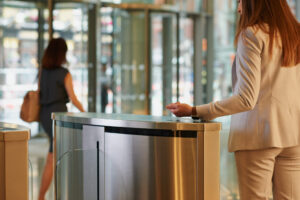Cloud security cameras stream network video to the cloud and they allow for remote viewing of footage from any approved device. These systems are becoming a more common choice as a business security camera system. They are frequently used by businesses with multiple locations as well as in schools, hospitals, and banks. The cloud is also capable of performing tasks requiring significant computational power, so cameras can operate more efficiently and securely.
A cloud-based camera can almost be thought of as a simpler and improved version of the IP (internet protocol) camera. IP cameras record footage and transfer it to an NVR (network video recorder) system for storage. Cloud cameras are significantly simpler in that IP addresses don’t have to be assigned to each individual camera for installation. Simply connect the camera to your network, and the job is done. Software included with a cloud camera will automatically handle sending data to the cloud, so there’s no need to set up any kind of network yourself to store footage. Updates are automatically installed to improve camera efficiency as well as patch any potential vulnerability. The biggest benefits of cloud cameras are their ease of installation and the fact that they require no additional software. Installation can be as quick as five minutes. Even with these advantages, however, there are some significant downsides to consider.
Wireless internet architecture
Possibly the biggest drawback of cloud cameras is that they need to be connected to the internet constantly in order to upload their footage. This can create a significant security risk whenever the internet goes down. Speaking of security risks, your video is available on an outside server, which some people may also not be comfortable with.
Bandwidth can also be an issue with these cameras. Particularly for larger organizations, which will inevitably need to install more cameras, having them all streaming at the same time may require more bandwidth than their networks can handle. Even just a couple of home security cameras may draw too much for many people’s networks. While some systems may allow for multiplexing, cutting down on this problem, it’s not a guarantee.
Local storage advantages
Many home security systems use local data storage, meaning that data from security cameras is stored nearby on a hard drive or SD card. Local storage is typically chosen for security reasons, as there’s little chance of the video being stolen or compromised when it’s on-premises. It’s also generally cheaper and charges no monthly fee for keeping your data on the cloud. Many local options also don’t require connection to the internet, so you won’t have to worry about lost data if your network is down.
Hybrid solutions
These days, a combination of cloud-based and local storage methods are generally considered the most effective. This setup is referred to as a hybrid cloud as it uses a mix of on-premises and cloud services to offer a secure and efficient experience.
Hybrid cloud cameras generally record their footage in two locations. Footage from each camera is recorded on their built in SD cards, so every camera has its own record. This data is also stored on the cloud, so there’s always a backup of footage, even if a camera is damaged or stolen. Live feed from each camera can be streamed to any approved device, making remote surveillance as simple as possible. Hybrid cameras also generally store processing power, so they can continue to record even when the network is down. Encryption on each camera ensures that its content can’t be stolen by malicious parties, and automatic patching of all cameras allows them to remain as secure as possible.







